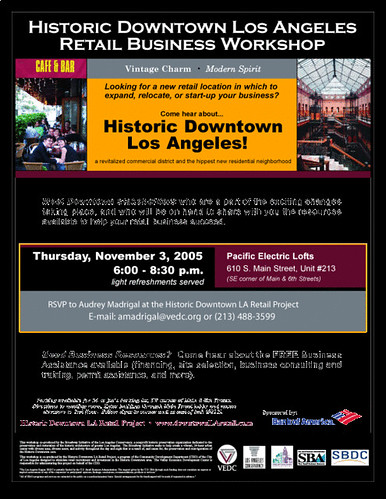Promoting Independent Retail
Yesterday, Michael Olesker, a columnist for the Baltimore Sun, wrote that "As 'burbs go urban, city retail must keep identity."
Here's what he wrote:
By all reliable accounts, including leaks from highly placed confidential sources inside the White House, I am among the last people in America to visit Wegmans, the new food store at the Hunt Valley Towne Centre. The TV news trumpeted Wegmans like the second coming of Harborplace. A lady in the store's meat department, Joyce McGee, said the crowds were so big the first week that they had "shopping cart gridlock. And you couldn't find a spot on the parking lot."
Don't get me wrong. I think Wegmans is very nice, and so is the imitation Main Street-style cluster of nearby stores and restaurants, all of which are finally breathing life into a shopping center that's been counted out more times than Mike Tyson.
But, to see us get so excited about a food store! What are we, Mayberry? In fact, maybe it's the faux-Mayberry look that touches us at Hunt Valley, the sense that Wegmans, and the accompanying Avenue-type strip of stores, is a throwback to a small-town look, a gathering-place feel that we lost when the enormous air-conditioned shopping malls began driving little mom-and-pop places out of business all over America.
As I mentioned last week, a couple weeks ago Baltimore released a retail market assessment report that declared that Baltimore is an attractive market for more retail businesses. (See "Mayor O'Malley Unveils Findings of Baltimore Retail Market Assessment.")
The problem is that most independent retail has died on the vine, and the infrastructure to support the development of independent successful businesses has withered as the various retail sectors (office supplies, clothing, restaurants, etc.) and the commercial real estate industry that develops and leases retail space have become organized as national and international enterprises.
This is something that Chris Leinberer talked about last week. He said that developers prefer national chains first, regional chains second, and local independent businesses only when there are no other alternatives. He said that in Albuquerque they flipped this and developed programs to help promote independent businesses, although he didn't go into detail about this, and I haven't followed up to see what they did/do.
Richmond and the State of Illinois have strong retail merchants associations, that provide a wide variety of services and training opportunities that continue to support the development and maintenance of independent businesses. Click here for the Retail Merchants Association of Greater Richmond or here for the Illinois Retail Merchants Association. These organizations include national chains as members, but provide a great deal of assistance to local and regional businesses. At the same time, to the best of my knowledge there is no equivalent association in the Washington region.
While various entities in the District of Columbia provide some services, I don't think it is nearly regular and extensive enough to substantively make a difference. At the same time, much of the city's resources are going into attraction and support of national chains, such as big-time exhibiting at the Las Vegas convention of the International Council of Shopping Centers or the provision of tax increment financing assistance to companies like Dress Barn or Home Depot, while few directed resources to improve extant businesses or to create independent businesses really exist.
See this piece from the Business Journal about the difficulties of making the TIF program work for independents "'Annoyed' retailers see no sign of D.C. TIF funds" and these articles about DC TIF monies going to national chains, "Jemal lands marquee retailer for Woodies building ," and "D.C. to consider incentives for discount retail in NE."
Interestingly enough, the City of Los Angeles has a major initiative to attract and develop independent retail in downtown, called the Historic Downtown LA Retail Project with extensive training, incentive, and development resources centered upon the development and strengthening of independent businesses. This brochure, Historic Downtown LA Retail Information Guide, describes the program.

One of the related programs, the Valley Economic Development Center, has extensive training programs including a regularly offered 8 session program on developing "Winning Retail Strategies*" as well as these current programs on offer: "Winning Strategies for Food & Beverage Businesses", "Winning Strategies for Art & Furnishings Businesses," and a "Small Business Workshop" for retailers interested in locating in downtown LA. (*A program like this needs to be regularly offered in DC.)
From the website:
Historic Downtown is the heart of Los Angeles, a lively marketplace, and a crossroads for all Angelenos.In the early 1900s, Historic Downtown was the destination commercial district for the LA region. Today, its historic buildings offer breathtakingly beautiful and unique spaces for mixed-use development. Creative businesses provide the perfect complement to upstairs live/work lofts, while new shops, galleries, cafes and nightclubs line the landscape of the city’s historic core.
As Downtown experiences an explosive demand for new shops, services, and entertainment, the growing residential community and the strong Downtown office market ensure a healthy customer base for new and existing businesses. Opportunities still abound in Historic Downtown, setting the stage for the rediscovery of Los Angeles’ most diverse and vibrant retail district.
They are actively developing four sectors of the retail economy: (1) shops and services; (2) art galleries; (3) cafes and restaurants; and (4) nightlife.
In an industrial environment where independent retail in many respects has been crushed, it is necessary to rebuild infrastructure in order to bring back independent retail. And cities could band together and begin developing "urban retail initiatives" to attract independents, such as by exhibiting at the National Grocers Association convention, which is the trade association for independent supermarkets (Safeway, Giant, and Harris-Teeter are not members...).
Etc.



0 Comments:
Post a Comment
<< Home